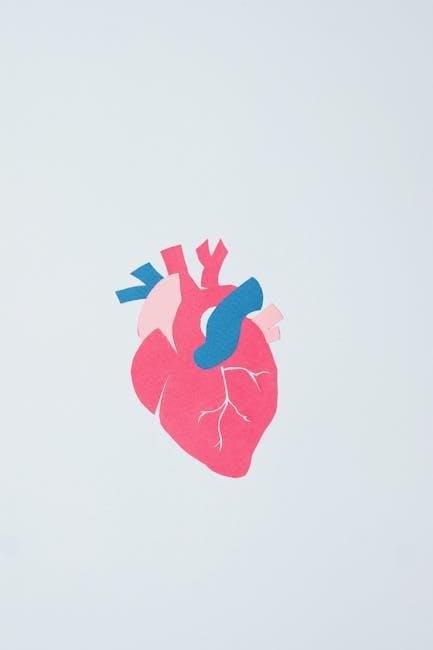The heart is a vital organ functioning as a muscular pump, maintaining blood circulation. It is approximately the size of a clenched fist, weighing around 350g, located centrally in the thorax. Understanding its anatomy is crucial for grasping cardiovascular physiology and clinical diagnostics.
1.1 Overview of the Heart’s Role in the Circulatory System
The heart is a central pump in the circulatory system, ensuring continuous blood flow. It receives deoxygenated blood and pumps oxygenated blood to tissues, maintaining nutrient delivery and waste removal. The heart’s chambers and valves facilitate this process, while its muscular walls generate the pressure needed for circulation. This role is vital for sustaining life and overall bodily function.
1.2 Importance of Understanding Heart Anatomy
Understanding heart anatomy is crucial for diagnosing and treating cardiovascular diseases. It aids in identifying abnormalities, guiding surgical interventions, and interpreting imaging results. Knowledge of heart structures like chambers, valves, and vessels is essential for clinicians to assess heart function and develop effective treatment plans.
Location and Position of the Heart
The heart is centrally located in the thoracic cavity, slightly offset to the left. It rests behind the sternum, protected by the ribcage, and is nestled between the lungs.
2.1 The Thoracic Cavity and the Heart’s Position
The heart resides within the thoracic cavity, a protective space enclosed by the ribcage and diaphragm. Positioned behind the sternum, it is slightly offset to the left, nestled between the lungs. This central location facilitates efficient blood circulation throughout the body, ensuring oxygenated blood reaches vital organs and deoxygenated blood is directed to the lungs.
2.2 Surface Markings of the Heart
The heart’s surface markings outline its position on the chest wall. Shaped like a cone, it extends from the sternal angle to the fifth intercostal space. The left border aligns with the left parasternal line, while the right border follows the right parasternal line. Surface anatomy helps in clinical assessment, allowing palpation of the apex beat at the fifth left intercostal space.

Pericardium
The pericardium surrounds the heart, consisting of fibrous and serous layers. It provides structural support and reduces friction during heart contractions, ensuring smooth cardiac function.
3.1 Structure of the Pericardium
The pericardium is a double-layered membrane enclosing the heart, comprising the outer fibrous pericardium and the inner serous pericardium. The fibrous layer provides structural support, while the serous layer secretes fluid to reduce friction during heart contractions. Together, they protect the heart and maintain its position within the thoracic cavity, ensuring optimal cardiac function.
3.2 Fibrous vs. Serous Pericardium
The fibrous pericardium is a tough, outer layer providing structural support and anchoring the heart. In contrast, the serous pericardium is an inner, double-layered membrane producing fluid to minimize friction. The fibrous layer protects and stabilizes, while the serous layer reduces friction, together safeguarding the heart’s function and maintaining its position within the thoracic cavity.
Heart Wall Structure
The heart wall consists of three layers: the epicardium, myocardium, and endocardium. Each layer plays a distinct role in maintaining cardiac structure and function.
4.1 Layers of the Heart Wall
The heart wall is composed of three distinct layers: the epicardium, myocardium, and endocardium. The epicardium is the outermost layer, providing protection. The myocardium, the thickest layer, consists of cardiac muscle responsible for contraction. The endocardium lines the inner surfaces, including chambers and valves, ensuring smooth blood flow.
4.2 Epicardium, Myocardium, and Endocardium
The epicardium, the outermost layer, is a serous membrane protecting the heart. The myocardium, the thick middle layer, consists of cardiac muscle cells enabling contraction. The endocardium, the innermost layer, lines chambers and valves, ensuring smooth blood flow. These layers work together to maintain cardiac function and structural integrity.

External Anatomy of the Heart
The heart is a cone-shaped, fist-sized organ in the central thorax, slightly left of midline. Its external features include surface markings and great vessels.
5.1 Chambers of the Heart
The heart contains four chambers: the right and left atria, and the right and left ventricles. The atria receive blood, while the ventricles pump it out. Valves regulate blood flow between chambers, ensuring unidirectional movement. These chambers are separated by septa, maintaining functional independence while enabling synchronized cardiac activity.
5.2 External Features and Surface Anatomy
The heart’s external features include the base and apex, with the base at the top and apex pointing downward. Surface anatomy reveals the anterior surface facing the chest wall and posterior surface against the spine. These features aid in clinical assessments, helping identify abnormalities and guide medical procedures effectively.
Internal Anatomy of the Heart
The heart contains four chambers—two atria and two ventricles—separated by septa. It includes atrioventricular and semilunar valves, ensuring proper blood circulation through the body.
6.1 Septa and Internal Walls
The heart is divided by septa into four chambers: right and left atria, and right and left ventricles. The atrial septum separates the atria, while the ventricular septum divides the ventricles. These internal walls prevent blood mixing and ensure proper circulation, directing deoxygenated blood to the lungs and oxygenated blood to the body, maintaining efficient cardiac function.
6.2 Valves and Their Functions
The heart contains four valves: mitral, tricuspid, pulmonary, and aortic. These valves ensure unidirectional blood flow, preventing backflow. The mitral and tricuspid valves regulate blood flow between atria and ventricles, while the pulmonary and aortic valves control blood exit into the pulmonary artery and aorta. Proper valve function is essential for maintaining efficient circulation and preventing cardiac complications.
Blood Flow and Circulation
The heart manages two circulatory pathways: pulmonary and systemic. It directs deoxygenated blood to the lungs and oxygenated blood to the body through precise valvular control.
7.1 Pathway of Blood Through the Heart
Deoxygenated blood enters the right atrium via the superior and inferior vena cava, flowing into the right ventricle through the tricuspid valve. It is then pumped to the lungs via the pulmonary artery. Oxygenated blood returns to the left atrium through the pulmonary veins, passing through the mitral valve into the left ventricle, and is distributed to the body via the aorta.
7.2 Arterial Supply and Venous Drainage
The heart receives its arterial supply primarily through the right and left coronary arteries, branching from the aorta. These arteries supply oxygenated blood to the myocardium. Venous drainage occurs via the coronary sinus, which collects deoxygenated blood from the myocardium and empties into the right atrium, ensuring proper circulation and maintaining cardiac function.
The Cardiac Conduction System
The cardiac conduction system regulates heart rhythm, starting with the SA node (pacemaker) generating 60-70 signals per minute. The AV node relays these signals to the ventricles.
8.1 Intrinsic Conduction System
The intrinsic conduction system includes the SA node, AV node, Bundle of His, and Purkinje fibers. It generates and conducts electrical impulses, controlling heart rhythm. The SA node acts as the heart’s natural pacemaker, initiating beats that propagate through the AV node to the ventricles, ensuring synchronized contractions. This system is modulated by the autonomic nervous system, adjusting heart rate based on body needs.
8.2 Role of the SA Node and AV Node
The SA node initiates electrical impulses, setting the heart rate, while the AV node delays these impulses, ensuring ventricles contract after atria. The SA node’s activity is influenced by the autonomic nervous system, increasing during sympathetic stimulation and decreasing during parasympathetic activity. This coordination ensures efficient blood circulation, maintaining proper heart function under varying conditions.

Surface Anatomy and Clinical Relevance
Surface anatomy provides crucial insights into the heart’s structure, aiding in clinical assessments and procedures such as chest X-rays and echocardiograms through precise anatomical landmarks.
9.1 Clinical Assessment of Heart Anatomy
Clinical assessment of heart anatomy involves non-invasive imaging techniques like echocardiography and CT scans to visualize heart structures, aiding in diagnosing abnormalities such as chamber enlargement or valvular defects. This non-invasive approach allows healthcare providers to evaluate heart function and identify potential issues without the need for surgical intervention, ensuring accurate and timely patient care.
9.2 Imaging Techniques for Heart Anatomy
Advanced imaging techniques like echocardiography, CT scans, and MRI provide detailed views of heart anatomy. Echocardiography uses ultrasound to visualize heart structures, while CT and MRI offer high-resolution images of chambers, valves, and septa. These tools are essential for diagnosing abnormalities and planning interventions, enabling precise assessment of heart anatomy in both clinical and surgical contexts.

Applied Anatomy in Medical Procedures
Applied anatomy is crucial for guiding surgical interventions and catheter-based procedures. Understanding heart structure aids in bypass grafting, valve repairs, and minimally invasive techniques, ensuring precise and safe outcomes.
10.1 Surgical and Interventional Anatomy
Surgical and interventional anatomy focuses on the precise localization of heart structures for procedures like bypass grafting, valve repairs, and catheter-based interventions. Understanding the spatial relationships of chambers, vessels, and valves is critical for minimizing complications. This knowledge guides surgeons and interventionalists in techniques such as CABG, TAVR, and ablations, ensuring accurate and effective outcomes.
10.2 Anatomical Considerations in Cardiac Diseases
Anatomical knowledge is crucial in managing cardiac diseases like coronary artery disease, hypertension, and heart failure. Understanding structural abnormalities, such as congenital defects or valve dysfunctions, guides diagnostic and therapeutic approaches. Accurate anatomical assessment helps tailor treatments, improving patient outcomes and reducing complications in cardiovascular care.
Learning Tools and Resources
Interactive 3D models, AR applications, and educational simulations provide immersive learning experiences. Detailed heart anatomy PDFs, slideshows, and videos by experts like Dr. Paul A. Iaizzo and JG Murphy offer comprehensive resources for studying cardiac structure and function, aiding both students and professionals in visualizing complex anatomical details.
11.1 3D Visualization and AR in Heart Anatomy
3D visualization and Augmented Reality (AR) revolutionize heart anatomy education. Interactive models enable detailed exploration of cardiac structures, such as chambers and valves. AR applications overlay digital anatomy onto real-world environments, enhancing understanding. These tools, like those using the Tetrad approach, provide immersive learning experiences, aiding medical students and professionals in visualizing complex heart anatomy dynamically and accurately.
11.2 Educational Models and Simulations
Educational models and simulations provide interactive tools for understanding heart anatomy. Physical models offer hands-on exploration of cardiac structures, while digital simulations allow real-time interaction with virtual heart models. These resources enhance learning by enabling students to visualize and explore the heart’s chambers, valves, and blood flow pathways in detail, making complex anatomy more accessible and engaging for learners.
The heart’s intricate anatomy is central to its function as a vital organ. Understanding its structure, from chambers to valves, underscores its role in physiology and medicine, guiding future cardiac research and clinical advancements.
12.1 Summary of Key Anatomical Features
The heart’s key features include four chambers (right and left atria, ventricles), septa dividing them, and valves ensuring unidirectional blood flow. The pericardium encases it, with the fibrous layer providing structural support and the serous layer reducing friction. Chambers and valves work harmoniously to maintain efficient circulation, essential for overall bodily function and health.
12.2 The Heart as a Central Organ in Physiology
The heart is central to physiology, functioning as a pump sustaining life through continuous blood circulation. It delivers oxygen and nutrients while removing waste, maintaining homeostasis. Its intrinsic conduction system ensures rhythmic heartbeats, adapting to demands like exercise, making it vital for overall health and bodily function.



